Though available
in cast resin and metal this is the first time to my knowledge this
AFV is available in small scale injection molded plastic.
The two-person H35, H38 and H39 were
developed in the late 1930s as an infantry (support) tank but were
instead used as a cavalry tank and with the similar-looking R35 tank
was one the most numerous tanks of the French armored forces in 1940.
After France fell in 1940 they continued to serve with Vichy France,
Germany, Yugoslavia and several of Germany’s allies. As I discuss
the four versions released by RPM below we’ll look at the differences
between them. The differences between the H35, the H38 and the H39
appear to be primarily the main gun and the engines.
Many of the comments for this vehicle
will also count for its similar variants below. Not having built any
of the kits I cannot say anything about if they are accurately 1/72-scale
or not.
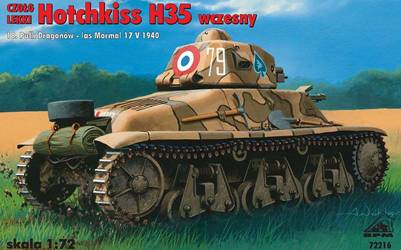
In the box art for RPM’s 1/72-scale H35 kit #72216
we have a ¾ rear view of an H35 in French markings and a two
color camouflage with black or gray outlines. On the turret side is
a playing card symbol commonly used for identifying platoons. The
tool handles on the side of the hull are in natural wood.
Atop the one-person cast steel APX
turret we see the dome shaped cupola that has a flap for sticking
signal flags out of; there is no cupola hatch which restricted vision
for the commander. On the rear of the turret is a large French roundel
on the large hatch that folds down so the commander/gunner can sit
partly outside and get a better view. We can’t see the short
37-mm SA 18 gun well from this view (the same gun used in the FT-17
tank of WW1). On the side of the turret is one of the three binocular-like
periscope viewports.
The upper hull is composed of six large
cast steel pieces which was an unusual manufacturing practice at the
time. Up at the front we see a round plate on the side with a vision
slit. The engine deck slopes down toward the rear which is a distinguishing
feature of the H35. On the rear there is no trench-crossing tail common
to these Hotchkiss tanks. There is a spare roadwheel at the back that
is accurately portrayed as black rubber, let me explain more: my references
and historical photos state that the H35 had (thin) rubber tired roadwheels,
while later H39 tanks had all-steel roadwheels and 2-cm wider track.
The rolled-up tarp below the wheel is not included in the kit.
The suspension is made of three bogies
of six roadwheels. The sprocket wheel is at the front and the idler
is at the rear, common to AFVs of the 1930s and 1940s. (The similar
R35 tank has five roadwheels on 2 ½ bogies.) The horizontal
springs look to maybe be covered in a black rubber boot but in photos
they are bare springs. The artwork appears to be a very nice and accurate
representation of an H35 tank.
There are enough parts in this box
to make either the H35 shown her or the H38 Series D version which
also has the short gun.

RPM’s kit 72217 shows what they call the H35
Model 1940 implying to me an H35 tank upgraded to 1940 standards
with the long 37-mm SA 38 gun. I cannot find this term (i.e. H35 Model
1940) in my reference books though. To the right of the gun we see
the gun sight port. Further to the right (the gunner’s left)
of the gun is a view port. Atop the turret is a better view of the
rotating commander’s cupola. On the opposite side of the gun
is a coaxial machine gun not visible from this view. The turret visors
are now the slit type.
On the cast nose we can make out the
company name HOTCHKISS cast into the piece. Above the nose is the
closed driver’s hatch and visor. The driver of the H35 and H39
sat on the right side of the vehicle while the similar looking R35
tank had the driver on its left side of the hull. To the right of
the driver we see another side viewing slit. There is no second, bow-mounted,
machine gun. The two round objects below the driver’s visor
may be air vents, or headlight fixtures as mentioned by one reference
book. On the left side of the AFV (our right) is the engine muffler
which appears to be exhausting the engine gasses forward?! I see no
handtools mounted on the vents. If we replace the muffler and the
engine deck with the others included in the box we can make an H39
variant.
The camouflage looks similar to that
of the H35 above but with larger green patches. Notice that there
is no radio antenna on these vehicles. Again the artwork looks accurate
and attractive and is great guidance for later painting our model.

The artwork for kit 72218, what RPM describes as
an H38 Series D. My reference states that the Char
léger Hotchkiss modèle 38 série D was the
factory identifier for the H35 with the more powerful engine, new
engine deck and improved suspension, more commonly known as the H39.
It appears the name H38 is commonly used for the H39 still armed with
the short SA 18 gun. The primary visible difference with respect to
the earlier H35 tank is the larger engine compartment for a more powerful
engine with a horizontal deck that no longer slopes down toward the
back, a slightly wider suspension and track, and a new style muffler
that exhausts to the rear. The muffler appears to have a sheet metal
guard. I see no trench crossing trail on the rear. By replacing the
engine deck and the muffler with other parts in the kit we can make
an H35 version.
The turret is the same APX-R as the
H35, also found on the French R35 tank. It still retains the short
SA 18 37-mm gun. This is a nice view of the large hatch and its hinge
on the rear of the turret. This kit’s turret is the same as
in the H35.
The tank is painted with a soft edge pattern of ochre and olive green; there
are no national or unit markings or vehicle numbers. Modeler Krzysztof
Trzyna has told me that this tank is part of an ad hoc half-company tank
unit under Polish Lieutenant J. Jakubowicz during the September 1939
German/Soviet invasion of Poland. The presence of the Panzer I as a combat
tank confirms this painting is set in the early WW2 period of 1939 to 1940.
The open driver's hatch implies the H38 vehicle is not attacking and the gun
firing to the rear implies that the vehicle is either retreating or being
attacked from the rear.
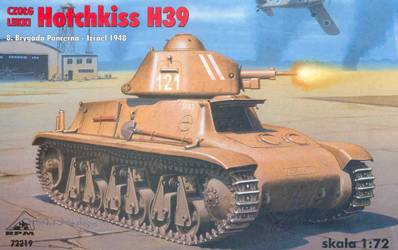
This fourth offering by RPM shows the final variant we know as the
H39, RPM kit 72219.
In this view we see the longer 37-mm SA 38 main gun and the dome-shaped rotating cupola with no hatch.
This is a nice profile view of the turret with the small external mantlet shield at the gunís base
and the large hinge for the turret hatch visible.
The external mantlet is not present with the short SA 18 gun; and not till assembling the turret
I noticed that RPM did not include a part for this external mantlet.
With care we can replicate the mantlet from thin styrene sheet.
The rear engine deck is the more horizontal deck for the larger engine.
On the rear of the track guard (fender) is a jack.
The roadwheels are all steel wheels and the steel rim should be a little thinner than portrayed here.
The vehicle is painted in tan desert
colors and Israeli markings set at an aerodrome during the Arab-Israeli
conflict of 1948. This and the other box art are missing towing chains
occasionally seen on French tanks.
The Kit Parts
The H35 kits have about 100 parts with about seven unused parts. The
H39 kit also contains about 100 silver-colored, injection-molded styrene
parts on two sprues and there are about seven unused parts (that are
for the H35 tank). I find this to be a lot of parts for such a small
model. The four RPM kits are exactly the same except for the two or
three parts for the main gun, the decal markings and small changes
in the kit assembly instructions. Most of the parts are common to
all four versions. The parts look to be well molded with many delicate
pieces, though there are several sink holes to fill in and some flash
around some of the many small parts.
The parts are designed by RPM so as to be able to produce as many
variants of the Char léger Hotchkiss modèle 1935
H tank as possible without reworking the kit sprues.
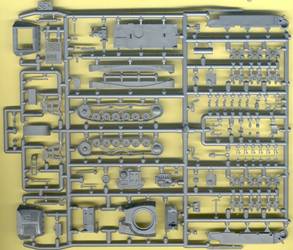
Above is one of the two sprues included in the box that is oriented
the same as in RPM’s numbered parts diagram in RPM’s assembly
instructions. At upper left is the H39 engine compartment (part 2)
with a separate engine deck next to it (part 3) to the right of the
engine compartment. At center far left are the parts for the optional
trench crossing tail (parts 6 7 & 8). At the lower left corner
is the sloping engine deck for the H35 tank.
In the sprue center are the two one-piece
track runs with the sprocket and idler wheels at each end and the
six roadwheels and two return rollers (parts 24 & 25). RPM did
better with these tracks than with their R35 kit’s tracks. I
appreciate the sag that RPM molded into the track. The roadwheel is
set down between the two rows of guide teeth on the tracks; unfortunately
the guide teeth extend straight across the track due the limitations
of molding the tracks this way. At upper right and lower right are
the suspension scissor-like arms (parts 38 and 41) that attach to
the roadwheels on the track runs.
Interior crew compartment parts include
a transmission at upper left, driver seat and levers at far center,
and the gun breach and coaxial machine gun for the turret interior.
All crew hatches are molded open. Thank you RPM. In the center below
the sprocket wheels is a rudimentary engine. I’ve seen no reference
photos for the engine compartment so detailing the engine may be pure
guess.
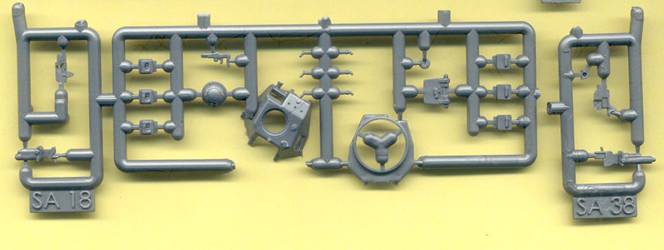
The second sprue has a center section with the turret parts, and either
a small 2-part sprue for the short-barreled SA 18 gun (at far left)
or a 3-part sprue for the longer SA 38 gun (at far right). The muzzles
of the gun barrels will need to be drilled out. I have read in Miro
Baric’s review of his RPM R35 Model 1939 that he found the
gun barrel of his SA38 gun (part 67) to have been broken. I have two
RPM kits with the SA38 gun and this gun barrel part 67 is broken in
both of the kits. This leads me to suspect that the broken gun barrel
is a consistent mold defect. Fortunately the broken gun barrel can
be replaced by a plastic rod or brass tube. The turret looks well
molded and all hatches are open. There are two types of visors: three
periscopic binocular-style visors at left which I’ve seen used
on some H35 and Renault R35 tanks, and three slit-visors at left right
that are to be used on these Hotchkiss tanks. This APX turret is the
same as in the RPM R35 kit.
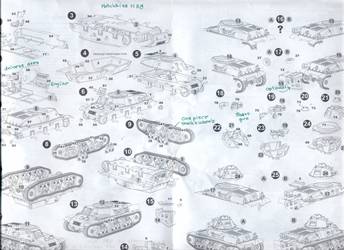
The instructions are broken down into 25 exploded-view steps. The
instructions look complete but very busy; I recommend that you study
them well. The only difference between the instructions for the four
Hotchkiss tanks kits are the sections for the different engine decks,
visors, guns and mufflers.
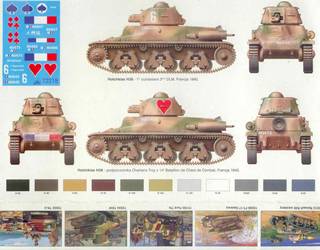
In addition to black and white guides for camouflage and the placement
of the markings there are color guides on the back of the box for
the complex camouflage; I find this an excellent and helpful way to
use the box. This artwork shows the kit 72218, H38 Series D kit.
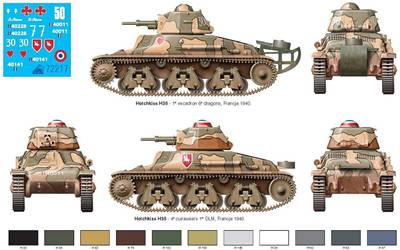
At the upper left of each box rear you can find the water slide decal
markings for the particular model. Not having used the decals yet
I cannot attest to how they are to work with or look when applied.
This is the H35 Model 1940, kit 72217 with markings for two French
vehicles of 1940. The upper vehicle has the trench crossing tail.
Atop the trail and in front of the spare wheel is a pan that is to
hold an auxiliary fuel tank (but the fuel tank is not included in
the kit). At the bottom is a paint color guide. On the hull side is
the muffler which is characteristic of the H35.
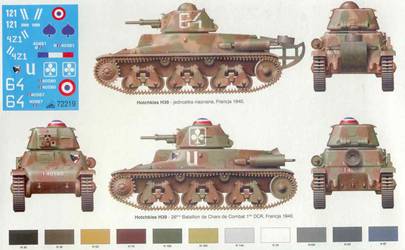
This artwork is the back of the H39, RPM kit 72219, the Hotchkiss
with the SA 38 gun and flat engine deck for the more powerful engine
and with French 1940 markings.
Some Conclusions
With other markings the H35 and H39 can be built as a French vehicle
in North Africa and Syria, or as a Polish, Hungarian and Bulgarian
vehicle.
Overall I really like the kit. After
I build it I’ll be able to say more about the fit and scale.
RPM improved the tracks over their earlier R35 tank kit but they still
could have done better. Interior references for the Hotchkiss tank
I’ve found to be rare; and to complicate this the engine compartment
and crew compartments for the H38 will differ from the H39, and the
turret interiors and crew compartments will have different interior
details based on the gun and respective ammunition stowage.
Modeling a Panzerkampfwagen
35H 734(f), PzKpfw 38H 734(f), or Panzerkampfwagen 39H 735(f) Beutepanzer
used by the German Heer and SS.
There are no parts to build any of the Hotchkiss Beutepanzers used
by the German army and at this time. RPM has, surprisingly to me,
not released a German version. But with some spare decals from another
kit and scratchbuilding we can convert this to an H35 or H39 in German
service. Below are some observations I have noted:
- Many German 35H and 39H tanks had
the dome cupola removed and a simple 2-part hatch installed.
- On some German 35H – 39H
tanks the cupola looks to just have been cut down four to six cm
tall and a flat split hatch installed.
- The vehicles were repainted by the
Germans in dark gray up to 1943 or even 1944; German 38H’s
present in France 1944 appear to be in Dunkelgelb and with brown
and green camouflage.
- If you wish to convert your model
to a towing vehicle or ammunition carrier (Munitions-Schlepper 35H
734(f)) you can use the spare turret for a bunker mount as found
on the Atlantik Wall.
- Some 38H’s had a storage box
mounted on the rear trench crossing tail.
- In Normandy, 1944, some 38H tanks
were fitted with four 28/32-cm rocket launchers, two per side; a
Stuka On Foot it was nicknamed. These rockets and launcher frames
we can steal from a 1/72 scale Revell, a Dragon or ESCI Sd.Kfz.
251 kit.
- In France, 1944, a number of H39
tanks were converted to self propelled Pak 40 tank destroyers, Panzerjägers,
and self propelled leFH 18 howitzers. (Some resin manufacturer should
produce a conversion to do this.)
Note:
Model Trans offers kit
MT72326 which is of a 1/72–scale Hotchkiss H-38/39 early
and late with options of two turrets, two guns and a German cupola
with open hatch. Nice!
References
- AFV Weapons 36, Chars Hotchkiss
H35, H39 and Somua S35, by Major James Bingham
- Captured French Tanks Under The
German Flag, by Werner Regenberg & Horst Scheibert, Schiffer
Military History.
- Trackstory No. 4, Renault R35 Renault
R40, by Pascal Danjou (2005). ISBN 2-9520988-3-2
- Henk
of Holland website
|